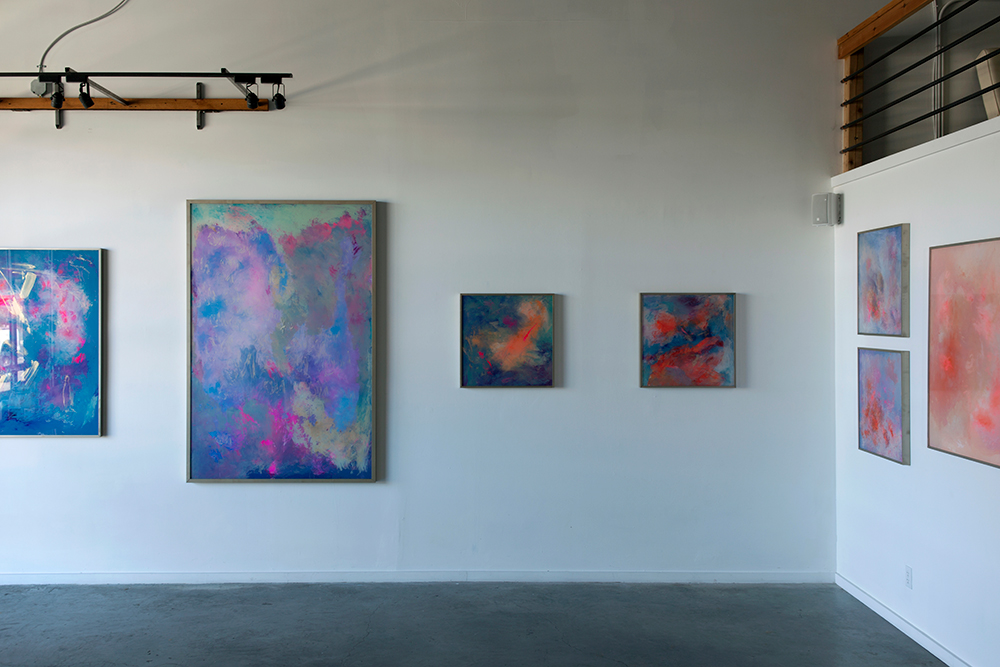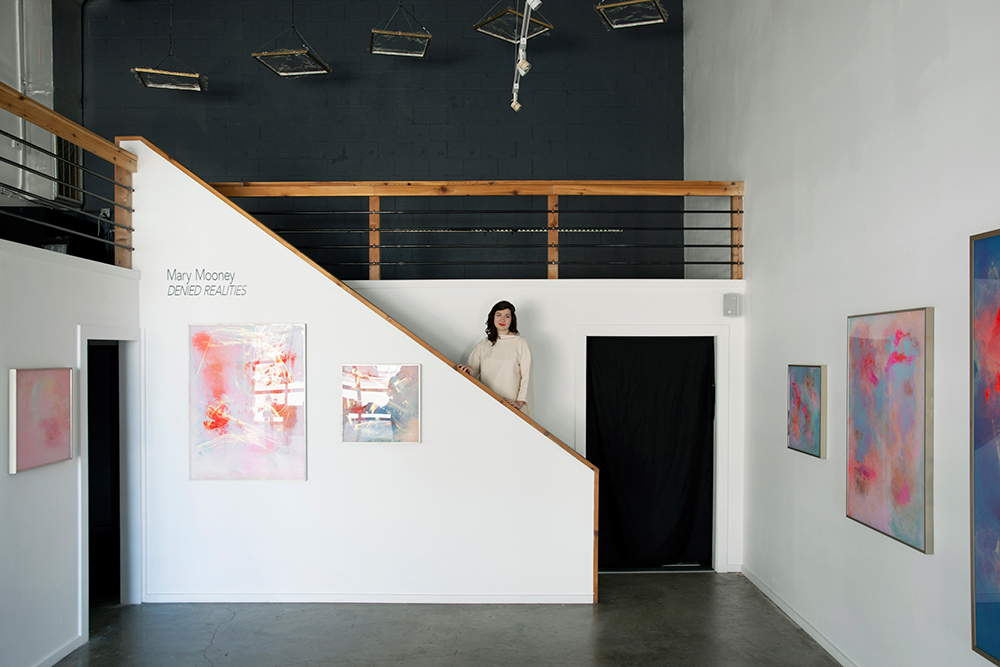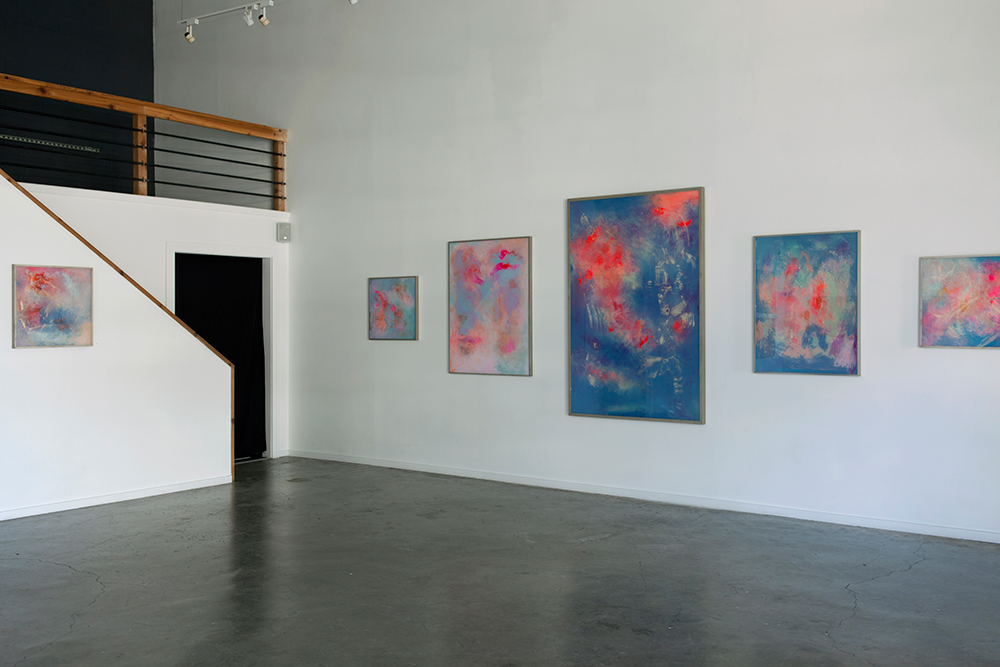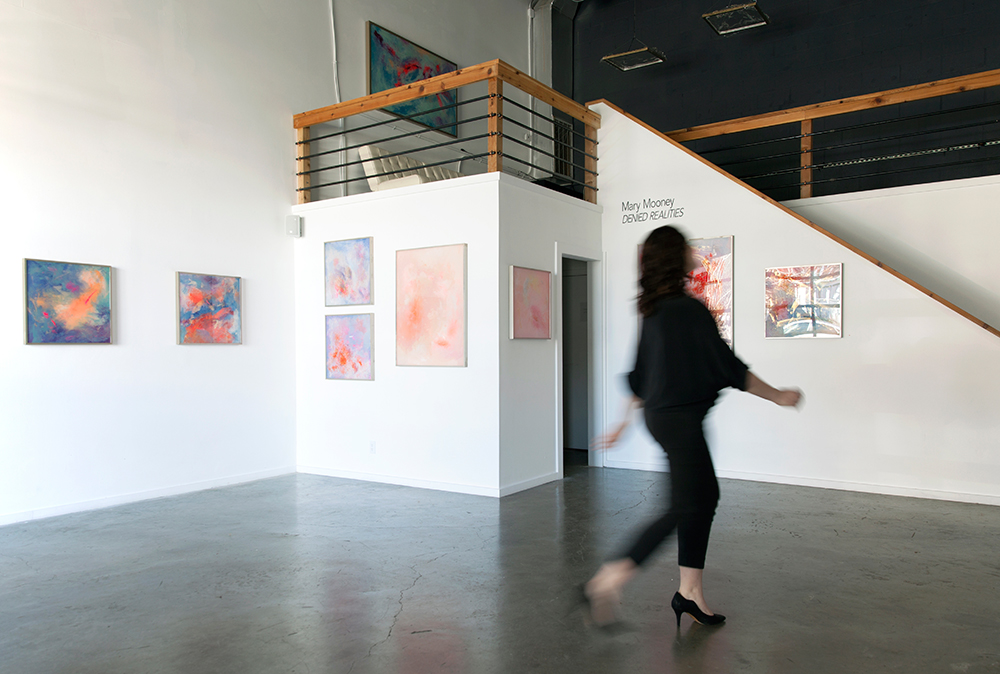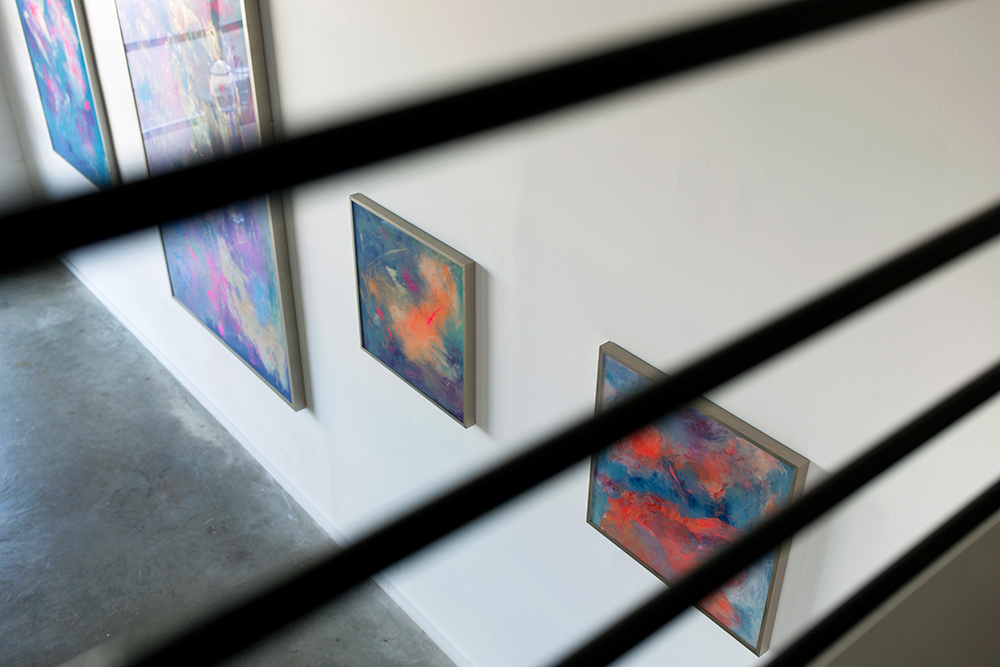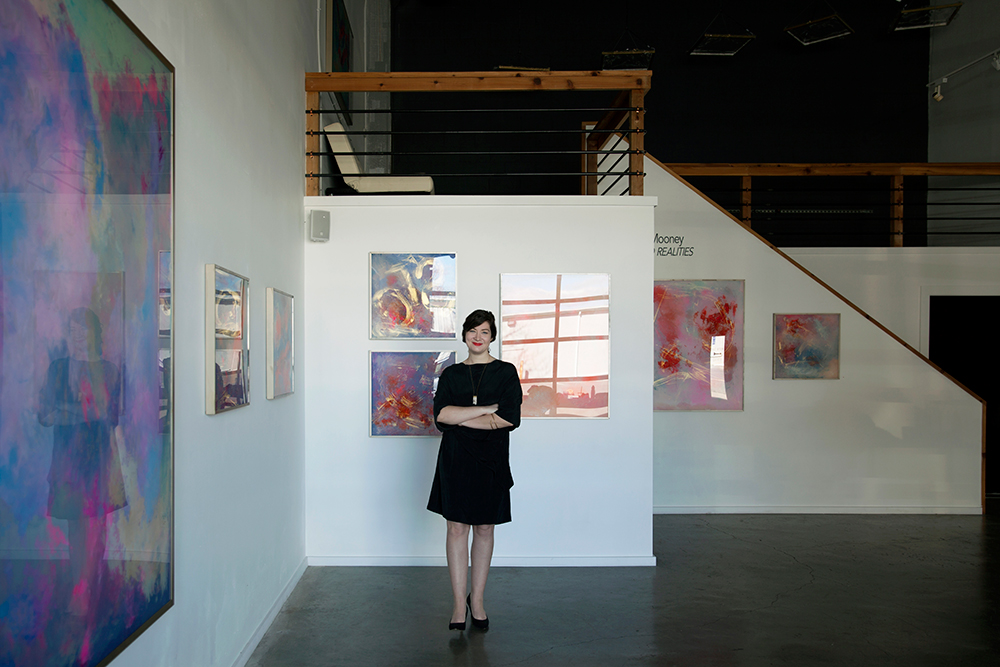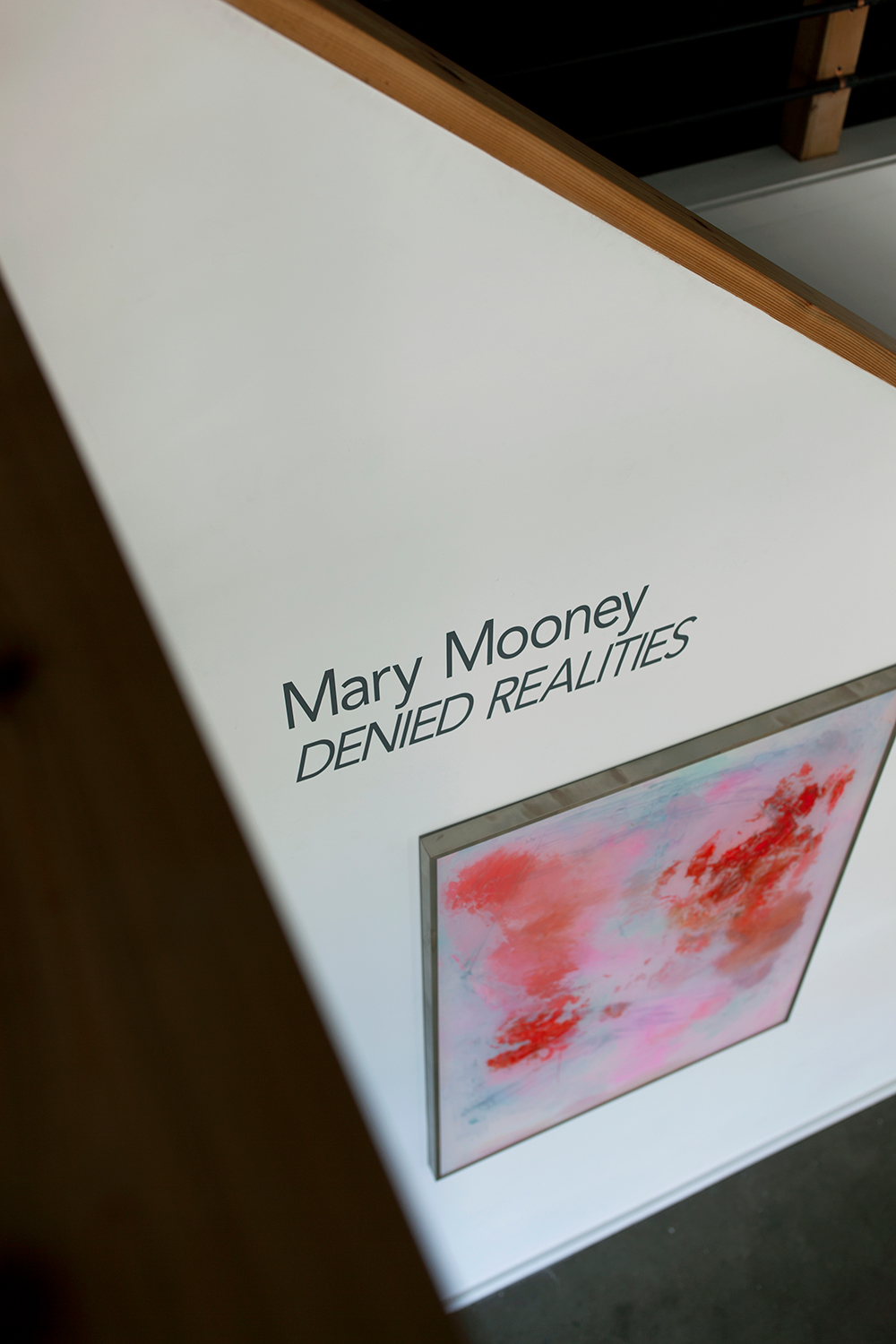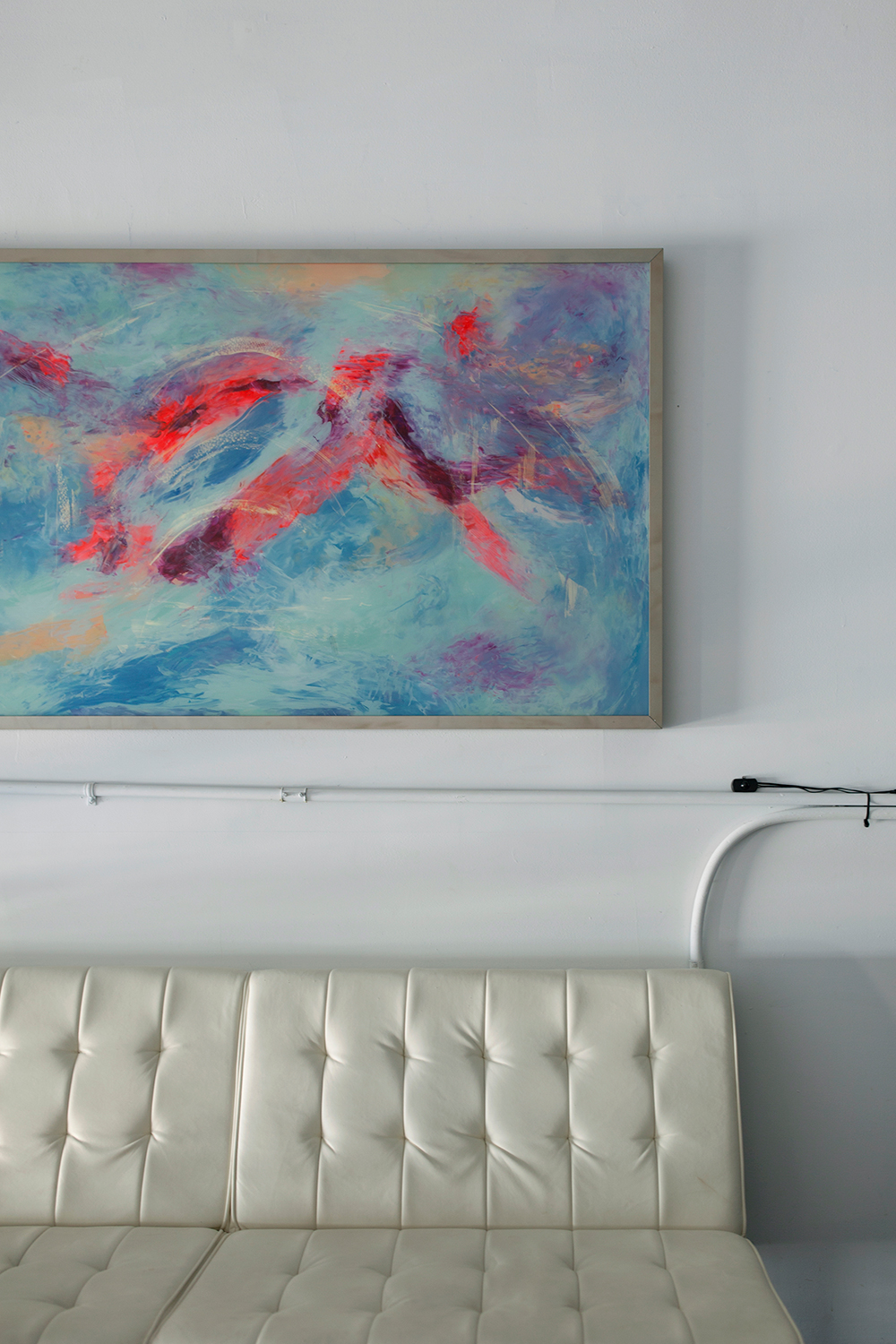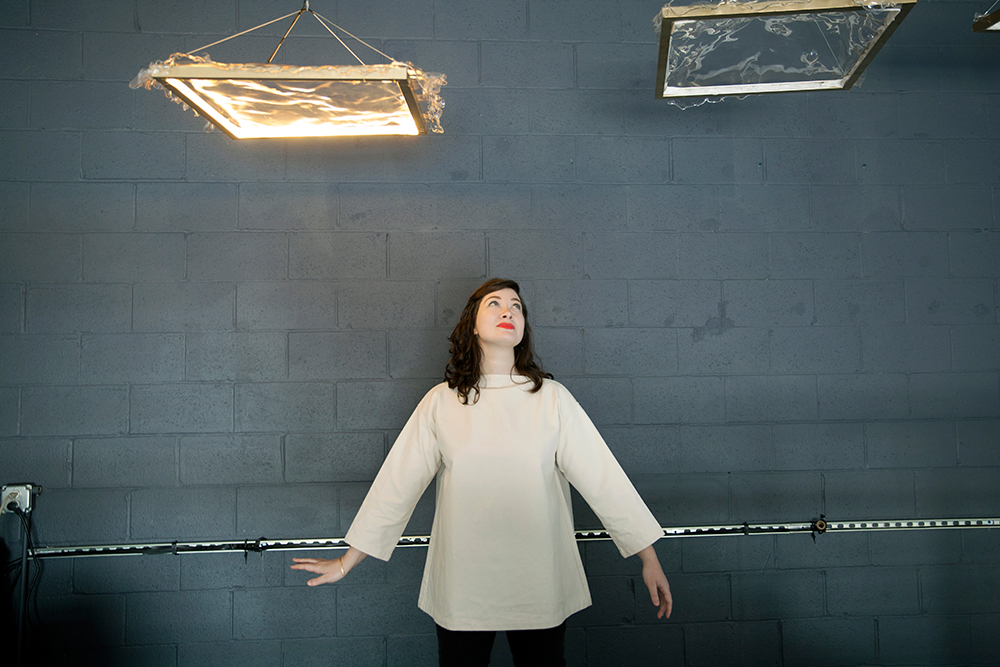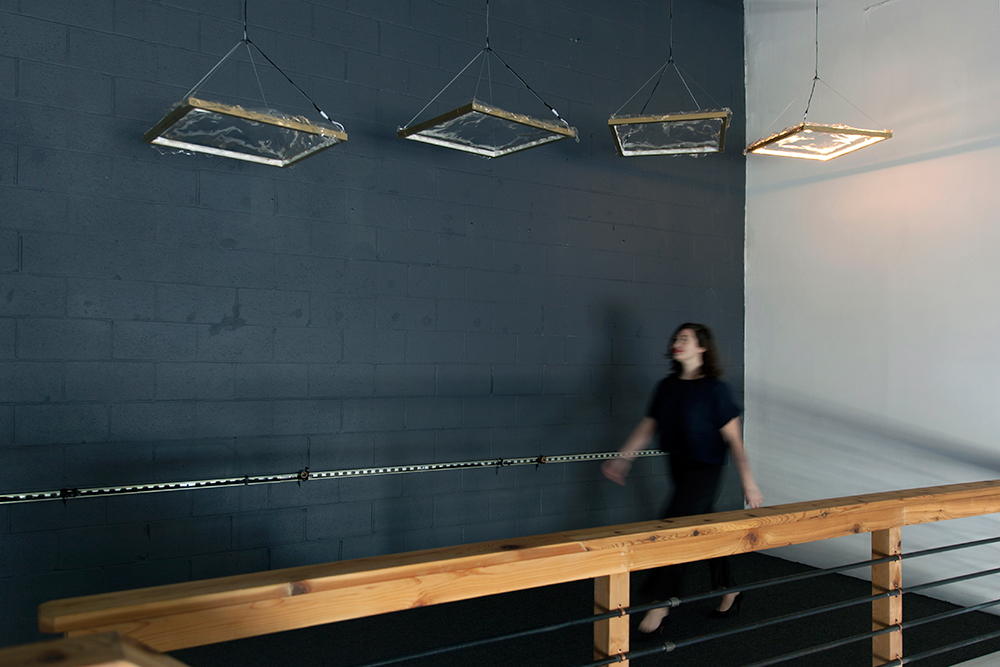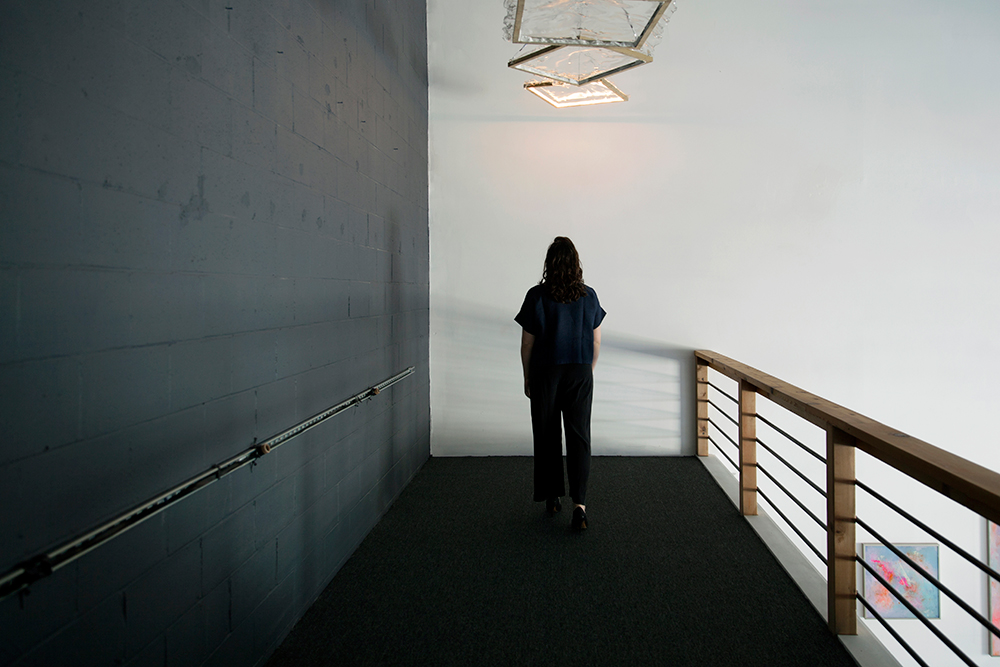Mary Mooney, Artist & Jewelry Designer
Mary Mooney is a professional fine artist and an accidental jewelry designer – and she’s very good at both.
Mary and I first met one afternoon about a year and a half ago at Wilder, the rad home design store in Germantown (keen readers will recall it from TCR Vol. 1). Wilder carries Mary’s necklaces — pendants made from gorgeous geometric mini-slabs of acrylic. They are shiny on one side and painted on the other with the same signature explosions of bright poppy color she uses in her larger abstract works.
The necklaces are lovely on their own, but they become even more interesting when you find out that they are the by-product of Mary’s fine art, which is executed on large acrylic panels that she paints from behind. (The process is a little like performance art: if you stand on the opposite side of Mary’s acrylic panel while she’s painting, you can watch as she applies and manipulates the layers of acrylic paint she uses in her work.) Mary started making the pendants as a way to recycle the leftover painted acrylic that she trimmed from her paintings. They really caught on. For many, Mary Mooney’s jewelry is a gateway drug that gets them hooked on Mary Mooney’s fine art.
It was several months after our introduction, as we were becoming friends, that I saw some of Mary’s large-scale works for the first time. They’re beautiful – like neon clouds in a particularly glorious sunset. For her most recent show, Denied Realities, which was on view at East Nashville’s Red Arrow Gallery last month, she depended on a color palette that was decidedly feminine, and unapologetically retro. In her program notes, Mary referred to it as “’80s Rococo”: think bright pink, baby blue, pale lavender, neon orange and flashes of gold. Some of the paintings in the show reminded me of the colorful residue that the Maybelline eyeshadow kits I bought in high school would leave when they broke and crumbled in the bottom of my makeup bag. Totally ’80s, indeed.
I attended Mary’s artist’s talk during the show’s run, and discovered that her paintings brought up different ’80s memories for other women. One said they made her think of Madonna circa her “Material Girl” days, while another was reminded of the Diane Keaton fish-out-of-water movie Baby Boom. During our interview for this piece, Mary herself admitted to being inspired by Reagan-era MTV.
However, while the eyeshadow colors of Mary’s paintings may be beautiful, with names like “Subtle Battles,” “The Only Way Out is Through,” and “Convenient Ignorance,” they’re much more than skin deep.
At the gallery talk, Mary spoke very openly with the moderator, her friend, the art historian and writer Sara Lee Burd, about groping incident she endured two years ago. Ultimately, the time Mary spent processing the event — talking with her husband and reading feminist literature (The Beauty Myth, The Gender Knot, A Brief History of Misogyny, et al) — provided the psychological framework and overall motivation she needed to produce Denied Realities, an exhibit that, she says, "explores how women’s expected societal roles subvert their actual experiences."
In our TCR chat, Mary and I talk about her experience with how creativity can come from adversity. We also touch on her creation and editing process; how she handles the age-old struggle that creative types face in balancing art and commerce; and how she fits into Nashville’s fashion community, which has been quick to embrace her.
Last year, the Nashville fashion company Elizabeth Suzann asked Mary to create a print for the paper they used to wrap their mail orders. It’s a gorgeous earth-toned pattern that is still shipped out with every ES order, which means Mary’s work is getting exposure well beyond Nashville’s borders.
For the shoot that accompanies our chat, Mary wore pieces from Elizabeth Suzann’s new collection. To make things even cozier, Chelsea O’Leary, who is ES’s marketing director by day, moonlit as photographer, shooting Mary posed among the paintings and light installation in the Red Arrow show. Enjoy.
TCR: When did you start working on the Red Arrow show?
MM: I really started six or eight months ago. It took a while for me. I hadn’t made a body of work in a long time. I was making work but I was still dancing around a strong concept. And I need a concept that I feel really good about. That has real purpose.
When I started reading all this feminist literature, it connected to so many other instances. Also having a solo show and putting myself on display. I mean, that’s what an art exhibit is. You’re being vulnerable and putting yourself out there for people to come and judge and experience, but also critique. And that nervousness I felt, I connected with being a woman and being vulnerable. And so it took me a while to tease that into this. Especially making work that is really “pretty” and creating abstract work in the climate of 2016.
TCR: I love that a show that’s so beautiful and pretty and light can represent rebellion. It’s like a girl in a frilly prom dress with the gun behind her back.
MM: That’s me! [LAUGH]
TCR: I wanted to know more about the groping incident you mentioned. I was really impressed by the strength you showed during the discussion by talking about it and its impact on your work.
MM: It happened at a party a couple years ago, where I was unwillingly groped by an acquaintance of friends. And while the act itself was of course upsetting, it was even more hurtful to have the incident then downplayed and marginalized by those I loved and trusted. I was told that it wasn't that big a deal, that "guys have done a lot worse," and that it would be great if I could make this person feel more welcomed instead of continuing to ignore him in social situations. My experience was secondary, inconvenient to the group, and ultimately led to estrangement from those once-close friends. This was so baffling to me, until these feminist readings help me put it into context.
Experiences like this get normalized all the time. I have let quite a bit go in the past not wanting to “rock the boat." But it turns you inward on yourself. You rationalize that you are the one who is too reactionary, or sensitive... or whatever the label is. Not only is that self-harming, but it prevents discussion and real behavioral change. This crossroads between the group and the individual, between convenience and difficult conversation ultimately became the main theme of what I’m now pursuing in my artwork.
TCR: How does that work for you? Like can you exorcise those demons by creating art?
MM: I think all of the work that I’m really proud of, now and in the past, has been a method of processing for me. And really, when I look at the themes of these older bodies of work that I was proud of, they were good kinds of coming of age moments for me. And the time that passed and the meditation I gave it, I think was what was helpful. But I didn’t finish a painting and have a eureka moment. [LAUGHS]
TCR: So it just helps you process. It’s like writing, like journaling.
Speaking of processing, talk about your editing process – or, rather, the curation process.
MM: You just move all the paintings around the gallery until you find the patterns that make sense. (Red Arrow gallery owner) Katie Shaw curated. And Sara Burd, who wrote the story about me in Nashville Arts helped.
TCR: I’ve actually never seen an actual curation in action.
MM: It’s fun. Before we moved to Nashville I was the director of a small museum and curated exhibits. It’s like anything: you get into a rhythm in your head and you know when it makes sense. You want to look at the color story it tells, but the order as well. We put the ones with words on the edge, so when they walked in people would see and then look — really look. You could see people especially at night kind of ducking and leaning around to catch the gold at different angles.
TCR: Changing the subject a little. Talk about your place in the Nashville fashion community.
MM: Oh, gosh. I just keep asking myself that. I mean the thing with Elizabeth Suzann felt so good. I hadn’t had anyone in the fashion community really celebrate my artwork. And it was really collaborative, but also open. They just sent me home with all these like beautiful fabric swatches that I just held… and dreamt about as clothing. [LAUGHS] They really gave me whatever liberty I wanted to translate them into a piece. It was very nice.
TCR: And they’re still using your piece for wrappings?
MM: Yeah. I'm still getting tagged on Instagram and people are putting it up in their homes and turning it into crafts. I haven’t done anything with them. I mean, I have some thumb-tacked up around my house.
TCR: You could wallpaper a room.
MM: I would love to.
TCR: So are you selling any jewelry right now?
MM: I still have pieces at Wilder. I’m still interested in growing the wholesale. But I really want my reputation to be my artwork. So maybe jewelry is my day job? It’s hard to let go; I have so much freedom with the jewelry. But then money’s freedom, too. You know?
TCR: Being a starving artist sounds kind of cool and sexy when you’re younger, but that’s unfortunately not the case at all.
MM: (Working a side job) might always be the situation (for an artist), even if you’re successful. In the beginning it’s fine, but ten or 20 years down the line, is it sustainable?
You know, and I’m not saying I'm doing it successfully right now, but this idea that you can build a website in a day or two with an ecommerce store… People just didn’t have that option ten years ago. I think there’s something to that, but I think that also you can’t give a hundred percent to everything. I can’t make and then promote everything. Where do you draw the line?
TCR: What does the landscape of the art community in Nashville look like? I know that there are galleries that represent different artists and that that creates a type of unofficial collective. But outside of that, is there a group you belong to that allows you to communicate and share ideas with other artists?
MM: I have a great group of friends who are artists. But the thing with artists is that their goals are so crazy, and widely different. I mean, I think all the fashion brands at the end of the day are running businesses. But art’s kind of the Wild West, where some people aren’t thinking about the financial end of it.
And it’s such a big spectrum that I think it’s hard to unite it under a single group. I’ve gone to the Makers Clubs that meets at Mickey’s (Tavern, a bar in East Nashville) when I can make it. And a friend has started a salon kind of discussion group, where we talk about different topics. There’s the Arts & Business Council. And that's wonderful, but it’s not the same kind of thing.
TCR: There’s a tendency for artists to keep to themselves.
MM: Yeah, that’s so true. I mean you’re working alone. I remember going crazy when I was working on my exhibit and it needed a lot of work. And I’m like, “I don’t know if this is doing what I want it to do!” So you have studio visits.
TCR: Does it help having people in to look at your work and give you feedback?
MM: Oh, yeah. It’s insanely helpful. I wouldn’t do a show without at least a couple of studio visits. I mean, I can have all the wild intentions for artwork, but if they’re not coming through, it’s not going to be successful.
TCR: It’s like being back in school and getting critiqued.
MM: Art school is so wonderful. And they’re just such a dedicated group that wants you to succeed. But (asking someone to provide professional feedback) is a big ask in the real world. It’s a lot to get someone to drive to your studio for an hour out of their day and to think critically about your work or help you price it. You know? These things are maybe even trade secrets for some people.
TCR: So you really can’t make art in a vacuum. You do need community support for much more than just showing up to see your exhibit.
MM: And Sara did that. I mean, I had some ideas, I was pulling palettes from art history and pop culture. But she was able to really speak to the depth of that in a way that went beyond the research I could do. She has a Masters in art history. She’s crazy about that the way I’m crazy about making work. That was a great studio visit.
TCR: Your paintings make me think of Sofia Coppola’s Marie Antoinette. That movie reads very pop and ’80s to me. It totally fits with the whole “’80s Rococo” thing you talked about in the show.
MM: This is so bad, but there’s a ZZ Top video called "Velcro Fly." It makes me think of that. It’s still a part of my childhood. No matter how woke I get, I can’t let it destroy everything that I associate with my childhood.
I took an abstract art course in college — and this is another reason studio visits are important, too, because there’s a way to read abstract art. The information you have is really turned down. There are no figurative elements. You have to look at the color palette, you have to look at the way brush strokes are applied, or if they even use them at all. Just the clues you have will tell. The title is a big part of abstract work.
TCR: Right, it all makes up the story.
MM: The story, yeah! And how they work in relation… Like all of these elements are important, but I’m so interested in how someone — an artist or an art historian — would look at it. And! I want to be really aware of how just Joe Somebody, Josephine Somebody, walking into a gallery would look at it, too. Because I don’t want to make work that’s just in this vacuum, this echo chamber. I want to think about how accessible it is on this bigger spectrum of viewership.
TCR: But in the case of abstract art, do you think that if they don’t read your artist’s statement and they don’t look at the titles, can someone still enjoy the art?
MM: I think there’s appreciation and there’s understanding. And I think the appreciation thing is like a visceral thing. But to have that level of understanding, you have to dig deeper and you have to have more information. You have to really sit with the work. And I can’t expect that from everyone. That’s the goal, but it’s not the expectation. [LAUGHS]
Chelsea J. O’Leary is a photographer and Sales & Marketing Director for Nashville-based Elizabeth Suzann. Her interests lie in responsible fashion, still life and travel photography, and philosophy. Learn more about her on her blog, Fenway Journal. She lives in Nashville’s Germantown neighborhood with her husband, dog named Jones, and cat named Albert.


